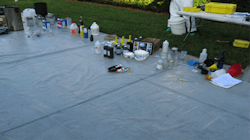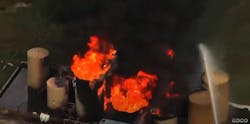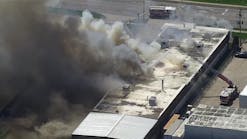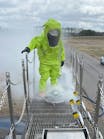Hazardous Materials Response: The Chemical Call
The number of methamphetamine labs and chemical suicides is on the rise in this country. Both involve extremely dangerous chemicals, as well as often unstable and dangerous people. These often-overlooked incidents raise new concerns, not just for the first-arriving responder, but also for emergency room staff, law enforcement and even the medical examiner. Early recognition of these events by first-in responders can make an impact on an already serious response, because once transported, viable victims in these situations can potentially shut down an emergency room if not properly cared for in the field first.
Chemicals involved
Common items to look for when determining the presence of a meth lab include drain cleaner, camping fuel, cold tablets, gas line anti-freeze, propane tanks, power drink bottles, matchbooks, starter fuel, etc. These items either include the chemicals listed below or are used in the cooking process:
- Red-P hazards: phosphine, red phosphorus converting from yellow or white phosphorus, sulfuric or muriatic acid, sodium hydroxide, hydrochloric acid, acetone.
- Nazi hazards: anhydrous ammonia, lithium, sulfuric or muriatic acid, sodium hydroxide, hydrochloric acid, acetone.
- One pot: ammonium nitrate, lithium, sulfuric or muriatic acid, sodium hydroxide, hydrochloric acid.
The types of chemicals used in chemical suicides are similar to those used in meth labs because they too are included in everyday consumer products, which can be broken down into the following two categories:
- Acid sources: muriatic acid, sulfuric acid, Lysol disinfectant, Lysol toilet bowl cleaner, The Works toilet bowl cleaner.
- Sulfur sources: artist oil paints, dandruff shampoos, pesticides, spackling paste, latex paints, garden fungicides.
The desired lethal products range from simple asphyxiants to poisonous gases, including hydrogen sulfide (H2S), cyanide (CN), organophosphates, helium (HE) and carbon monoxide (CO).
As you can see, both types of incidents involve an array of chemical hazards, which include lower explosive limits (LEL), corrosives, poisons and oxygen-deficient atmospheres.
First-arriving units
Most first-arriving units do not carry air-monitoring devices, but you can still take some basic steps to keep your crew and yourself safe. Either incident type can be dispatched as a “check the wellbeing” call or an “unknown type odor in the area” call. So if you’re the first-due officer or person in charge, it is your responsibility to ask additional questions of your dispatcher, and perform a thorough scene size-up, especially if you suspect that you’ll need assistance from law enforcement. Every crewmember should also take note of what they observe upon arrival and share their findings.
Always try to approach the scene from the windward side, as this will prevent you from accidentally entering a chemical environment. In several cases, the person attempting a chemical suicide has taken great steps to warn first responders; however, a slow approach is still warranted. Every member should remain vigilant and have a full understanding of a previously determined exit strategy. A well-prepared first responder has drilled on, or at the very least, discussed these measures, just as they would their duties on a fire call.
Let’s review strategies for two types of calls—someone passed out behind the wheel and an unknown odor call.
Passed out behind the wheel:
- Take a few extra seconds to approach the vehicle from the windward side.
- Do your size-up: Is anything leaking from the vehicle? (The individual may be carrying chemicals in the trunk or back seat for a meth lab, or they may have just left a home improvement store.)
- Do you notice any signs from a distance that indicate a possible chemical suicide? Is there a yellowish haze or powder visible, which would indicate a H2S suicide? Remember that in some H2S suicides, air monitors have registered readings in excess of 1,000 parts per million (ppm), which is 10 times the maximum IDLH exposure limit.
- The individual may have ingested some type of organophosphate, in which case there may be no indication of illegal or dangerous activity until you open the vehicle door. This can be very risky; therefore, SCBA is always recommended. Air is cheap, and it doesn’t take long to refill an air bottle.
Unknown odor
- Again, we want to try and approach from the windward side.
- Meet with the caller if possible and get more intel. Try to determine whether the smell is caused by human decomposition, or if it’s mercaptan caused by a possible propane or natural gas leak. And remember their properties: Natural gas rises while propane sinks, but both can pocket in areas of concern.
- Try to determine whether there has been a lot of vehicle traffic in the area, or people coming and going. This could indicate the presence of some type of drug activity. Tip: It may be a good idea to meet law enforcement at a remote location to see if they have intel before knocking on doors.
- Determine whether this incident has caused a fire or explosion, as it is common for drug labs to involve these types of events. This is why it’s crucial for all first responders to wear all PPE, even during overhaul: Ordinary household items are highly flammable, but chemicals from a drug lab are even more dangerous. If a lab is discovered after a fire, all fire department efforts should be halted and law enforcement contacted. Consider on-scene decon of all hoselines and PPE, followed by documentation of who was on scene, to determine any possible acute/chronic effects.
Managing patient or body
Once the scene has been discovered, and law enforcement or hazmat has been called, what about the patient or body? Do you have a protocol for either in the way of decontamination? Of course, the contaminated individual and anyone else who’s been involved with the incident—even if discovered after a fire—should be decontaminated. Other steps to take:
- Patients (who may also be drug suspects) have to be given a complete and thorough decontamination. Clothes are stripped, then tagged and bagged as possible contaminated material.
- Advise the hospital of the incoming situation and issue a “hazmat alert.” (More on this later.)
- Always protect the attendant in the back of the ambulance. This is accomplished with a simple facemask and the appropriate canister/cartridge, gloves and gown. The windows must also remain open, and if the ambulance is equipped, the ventilation system must be engaged.
Readying the ED
Once notified of a contaminated patient, enact local protocol, but keep in mind that it may not be necessary to initiate the complete contaminated patient plan for the emergency department (ED). Specifically, the patient will likely have been decontaminated on scene, which should be sufficient. This determination will come from the hazmat officer on scene.
En route to the hospital, make sure the isolation room, if so equipped, is ready. Remember: Several hospitals use this room as a storage area, so staff may need time to prepare it. Other steps:
- Move non-essential patients and personnel out of the area. No matter how much you practice, we must keep the chances of cross contamination and exposure to a minimum.
- Tell staff, nurses and doctors to be ready, and to don proper PPE. Admitting staff must remain out of the area.
Dealing with the deceased
When dealing with a dead body, remember this is most likely a crime scene until proven otherwise. The fire department must work in conjunction with law enforcement and the medical examiner’s office. Additional steps to keep in mind:
- The fire department may need to ventilate the vehicle or occupancy. Continuous air monitoring by a hazmat team is a must for everyone’s safety.
- The body may need to be decontaminated prior to transport by the medical examiner.
- Assistance at the medical examiner’s office may also be required.
Sample hazmat alert protocol
Earlier in this article, I mentioned the term “hazmat alert.” Several departments around the country use terms like “trauma alert,” “stemi alert,” etc., to inform emergency room staff of what to expect upon their arrival; the term “hazmat alert” basically accomplishes the same thing. But remember: When dealing with a meth lab patient or chemical suicide, it is important that you reiterate to the ED that the incoming patient has been decontaminated. If you do not inform them of this, they may implement their contaminated patient plan, which may shut down the ED.
Following is an example hazmat alert protocol from Orange County EMS in Florida, as provided by George A. Ralls, MD, Medical Director; Christopher L. Hunter, MD, PhD, Associate Medical Director; Salvatore Silvestri, MD, Associate Medical Director; and Maurice Mascoe MD, Associate Medical Director.
Hazmat alert purpose: Improve management of patient care scenarios involving hazmat exposures by creating a standard method to accomplish the following:
- Early notification of receiving hospitals of an incoming hazmat patient.
- Early involvement of hazmat teams in decision making.
- Early involvement of the region’s Poison Control Center or medical control when needed.
- Assignment of an EMS liaison to assist the ED in preparing for arrival of the patient.
- Establishment of unified command between EMS and the receiving hospital.
- Preparation for an EMS system to initiate “status black” when needed, to redirect EMS transport traffic until the hazmat alert has been cleared.
A hazmat alert should be initiated for the following scenarios:
- At the time of dispatch, when a caller reports a medical emergency involving a chemical smell or hazmat exposure. Do not otherwise interfere with the standard dispatch process.
- When the first-arriving crew suspects a hazmat exposure due to odor, history or other source of information.
- If hospital ED staff suspect a walk-in patient has been exposed to a hazmat situation and additional resources are needed.
If any of these situations occur, immediately contact the dispatch center and initiate a hazmat alert. Advise the communications center of the EMS transport destination as soon as one is determined, and employ all agency standards to protect crewmembers from avoidable exposure.
Once the hazmat alert has been acknowledged, the communications center will:
- Notify the responding agency’s hazmat team.
- Dispatch a single unit to the receiving hospital to assist in transfer of care (via the EMS liaison).
- Provide a “heads-up” notification to the intended receiving hospital.
- If requested, place the ED on “status black” (EMS systems) until it is determined safe to resume EMS transports.
Once notified of the hazmat alert, the responding agency’s hazmat team should contact the on-scene crew to accomplish the following (which may or may not require a hazmat team response):
- Determine the nature of the exposure and the required PPE level.
- Provide input on an appropriate decontamination strategy.
- Advise on treatment in coordination with Medical Control or Poison Control.
- Determine when transport can be safely initiated. First-responding crews should await input from the hazmat team prior to initiating transport.
When transferring care, transporting crews should contact the ED or EMS liaison prior to arrival at the hospital to convey Screener and Opioid Assessment for Patients with Pain (SOAPP) information and the specifics of the decon strategy employed on scene. Remember: Before entering the ED, allow hospital staff to assess the need for additional decontamination. The EMS liaison or hospital staff will also meet arriving crews outside the ED door. Once on hospital property, all further medical care is directed by ED staff.
Protect and preplan
Because of the nature of chemical-related calls, it’s critical to remain alert at all times and request resources early to protect your crew, the public and yourself. Remember: As the first-arriving unit, the impact of your initial actions will stretch far beyond the incident scene, which is why it’s also crucial to establish a working plan now—not at 3 a.m. or at the scene. Meet with your local police department and ED to start pre-planning discussions, if you haven’t already, to ensure a smoother and safer operation for all.
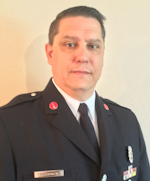
Robert Coschignano
ROBERT COSCHIGNANO has been in the fire service for 25 years, most of which were spent in Special Operations. He has served on several hazmat-related committees and currently serves as an instructor and evaluator for several local, state and national competency drills. Coschignano is the program manager for the Hazardous Materials Technician program at Valencia College and is DEA certified in Clandestine Labs. He is also the sales and training manager for HazSim LLC. Coschignano co-authored the Chemical Card Guide and Risk Based Response Quick Chemical Access Cards, and has been featured in several fire service magazines. He holds an associate’s degree in fire science and is currently a hazardous materials lieutenant with the City of Orlando Fire Department.
